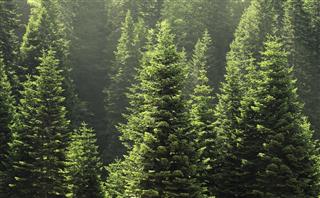
Black Hills spruce trees are hardy and slow-growing. These pyramid-shaped trees are highly popular for ornamental purposes. Here are some tips for growing Black Hill spruce trees.
Spruce trees are often grown as windbreaks, fences, and accent plants. Being dense and hardy, they are excellent for these purposes. These trees are also grown for shade, and for preventing soil erosion. They are also used as Christmas trees. There are around 35 different spruce species with several subspecies.
Black Hills Spruce
This tree is a variety of the spruce species called Picea glauca, that is otherwise known as white spruce. While Black Hills spruce is said to be a variety of the white spruce, such classification is a much-debated topic, as some experts refuse to accept the same. The Black Hills spruce is scientifically termed Picea Glauca Var. densata/Picea Glauca densata. These trees are native to the Black hills of South Dakota, where they are found abundantly, that too at elevations of more than 6000 feet.
As compared to the original species, i.e., white spruce (Picea glauca), the Black Hills spruce is slow-growing and smaller. The latter has a darker foliage, which is found to be denser than the white spruce. The leaves or needles are greener in Black Hills spruce, and the cones are smaller. These trees are mostly conical in shape. The branches are compact and stout, with an ascending form of growth. Its bark is brownish or ash in color, and is flaky in nature. These trees are adapted to extreme cold temperatures.
How to Grow Black Hills Spruce Trees
- These trees must be planted in well-drained and moist soil. Though Black Hill spruce trees are found to be drought resistant to some extent; they need moisture, till they establish themselves.
- As they have a shallow root system, these trees tend to get dry very fast. It is always better to plant them in soil, that is rich in organic matter. If not, you may add compost and other such materials to the soil. The ideal soil pH range is 4 to 7.5.
- The location must have good sunlight, but partial shade is also suitable for growing these trees. You need to dig holes, that are at least twice as big as the root balls. The top portion of the root ball must be above the ground by one or two inches, after planting.
- You may also apply a small amount of fertilizer at the time of planting. Mulching will be beneficial for the plant, as it helps to retain moisture of the soil.
- Daily watering is recommended, during the initial stages. After that, reduce the frequency to once a week; or water them, as and when the soil gets dry.
- Though these trees are found to be resistant to pests and diseases, they are susceptible to attack of spider mites, needle and stem rust, canker, trunk and root rot. However, most of these conditions can be tackled with proper care and preventive measures.
As stated above, the growth rate of Black Hills spruce trees is very slow. If provided with ideal growing conditions, they may grow to a height of around five feet in five years. You may approach a horticulturist or the local nursery authorities, if you want more details about growing Black Hills spruce trees.







